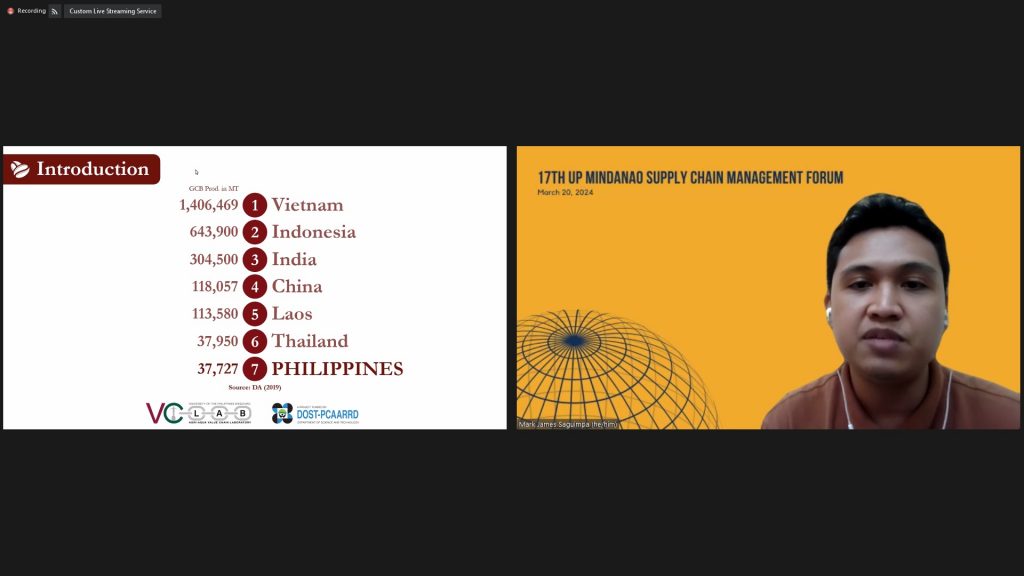

A University of the Philippines Mindanao (UPMin) researcher offered recommendations to improve the incomes of Robusta coffee farmers at the recent 17th Supply Chain Management Forum on “Sustainable Growth and Optimization in Agricultural Value Chains,” which was held online by the UPMin School of Management (SOM).
Researcher Mark James Saguimpa reported that at least 80 countries produce coffee, 50 of which are developing countries, with the Philippines ranking 23rd globally and 7th in Asia. In 2019, the Philippines had a gross coffee bean production of 37,727 Metric Tons, with SoCCSKSarGen Region (Region XII) accounting for 34.57% of this volume.
In his study “The effect of elevation on the technical efficiency of Robusta coffee farms in Sultan Kudarat, Philippines,” he disclosed that many of these coffee producers are smallholder farmers with 21 years of farming experience, live in a four-person household, were able to reach high school (51.27%), farm at a medium elevation (48.01%), and earn approximately PhP 5608.04 and PhP 40373.88 in off-farm activities and coffee farming alone, respectively. Regarding land and yield, the average Robusta coffee farmer respondent has a total land area of 4.91 hectares (ha.) and produces 1,055.55 kg of coffee cherries per ha. Regarding other inputs, the average Robusta coffee farmer uses 144.39 kg of fertilizer per ha. and has 499 coffee trees per ha.
The Department of Agriculture (DA), for its part, assists through the provision of planting materials and farm inputs, postharvest facilities, credit and market access, education programs, and Good Agricultural Practices standards.
However, Researcher Saguimpa said Robusta coffee farms face challenges and issues regarding input acquisition, processing, marketing, transportation, and capacity-building.
Still, farmers could further improve their productivity if they overcome prevalent low farm productivity, low soil fertility, tree senility, pests, and plant diseases.
“A farm’s coffee yield increases with the amount of fertilizer inputs and an increased number of planted trees,” said Saguimpa.
He said farmers could achieve higher yield by acquiring more technical skills and knowledge, accessing additional postharvest facilities, and expanding credit and market access.
“Also, a medium elevation in altitude, such as a farm situated between 501 to 1,000 meters above sea level, significantly improves technical efficiency or improved coffee bean outputs for the least amount of input,” he said.
Furthermore, he recommended that coffee industry players take action to “improve access to inputs, markets, and infrastructure and to promote sustainable farm practices such as agroforestry.”
He also suggested that farmers and industry players “assign a premium to consumers who demand sustainable coffee production,” which does not deplete natural resources and is communicated through eco-labeling.
“These recommendations can contribute to improved income for all coffee growers and entrepreneurs in the entire coffee value chain,” he concluded.
Research Assistant Adrianne John Nuneza, in his research “Factors influencing market outlet choice of coffee farmers,” disclosed that price is the key factor in the coffee farmers’ dilemma of whether to sell their beans to direct buyers or traders and that direct buyers offer higher prices.
He echoed the other researcher’s need for farmers’ farm-to-market roads and post-harvest facilities, access to low-interest credit for agricultural inputs, subsidies to alleviate transport costs, and timely and accessible market price information.
Finally, Researcher Dave Laurence de la Cruz, in his study titled, “Can a Sultan Kudarat farmer afford a Spanish Latte?” concluded that farmers cannot afford this special coffee mix that is made from their produce and sold in upscale cafes. In two coffee-growing towns in Region XII, de la Cruz discovered that coffee farmers’ gross income from coffee bean production, ranging from P22,000 to P47,000 annually, is insufficient for their expenses, requiring the farmers to seek additional income such as from other crops or from employment.
The forum, hosted by the DOST-PCAARRD-funded Agri-Aqua Value Chain Laboratory, was part of UP Mindanao’s 29th anniversary celebration. The UPMin supply chain research addresses the Sustainable Development Goals of No Poverty, Quality Education, Decent Work and Economic Growth, among other goals.
Article from UP Mindanao PRO
